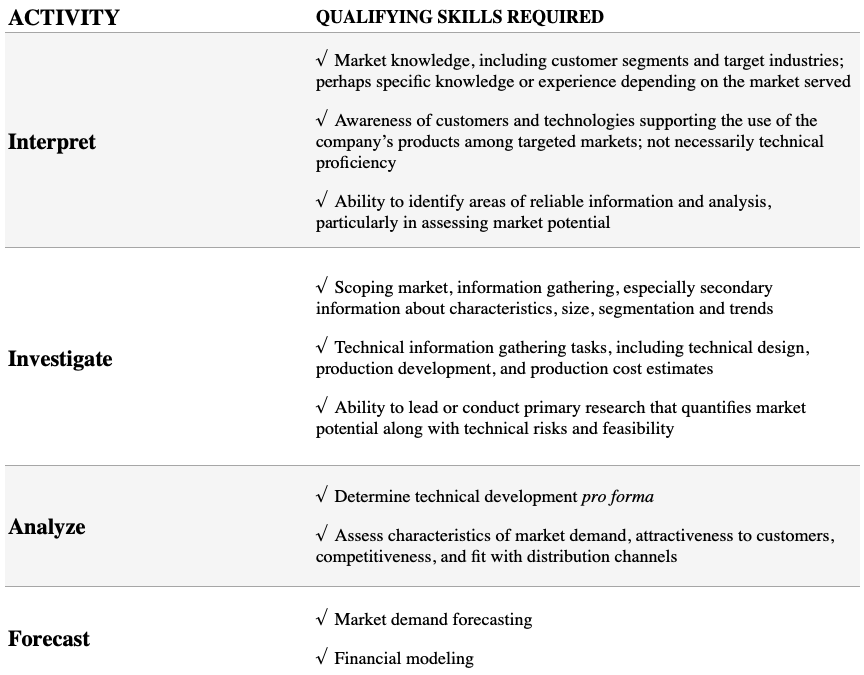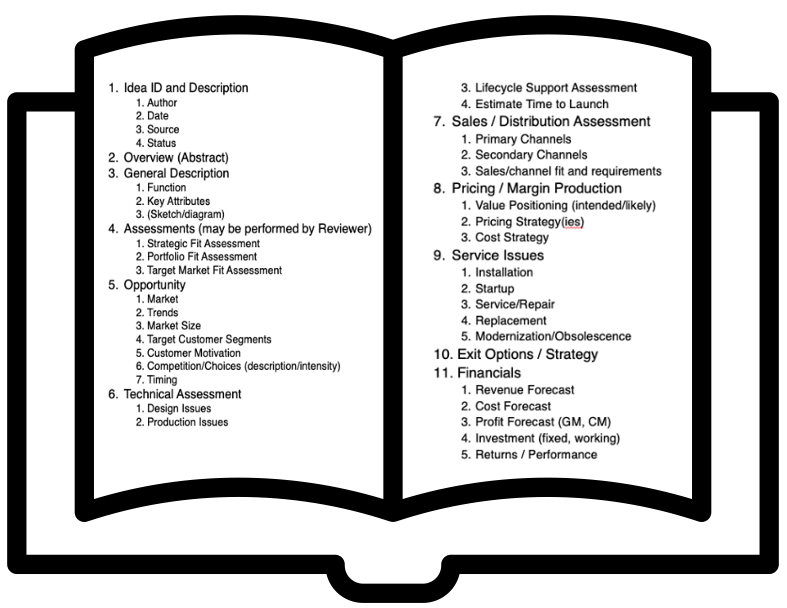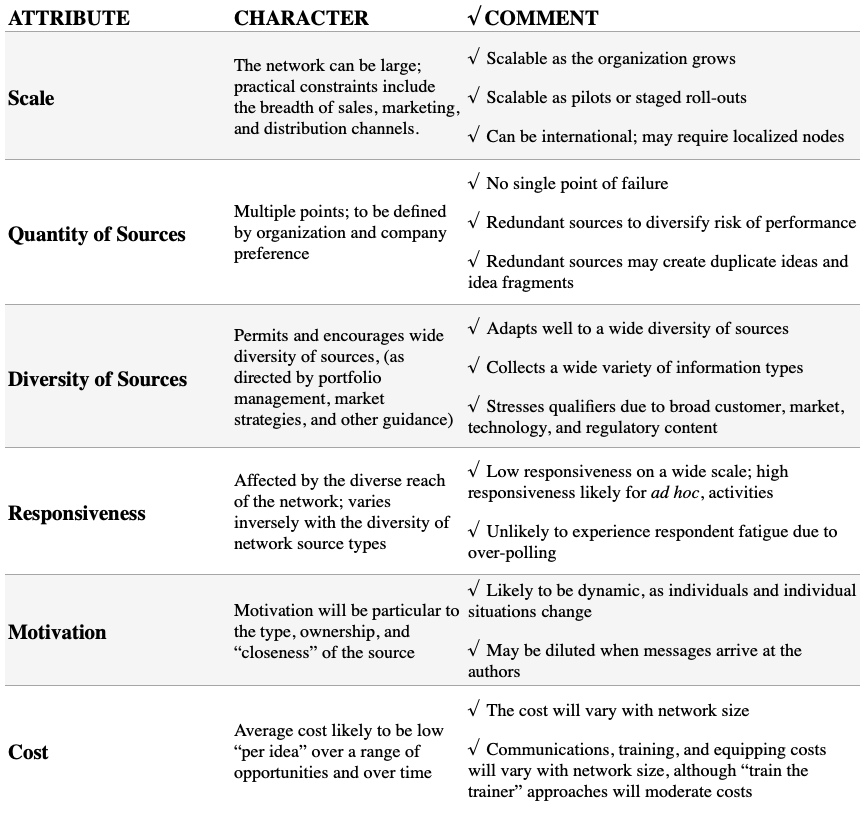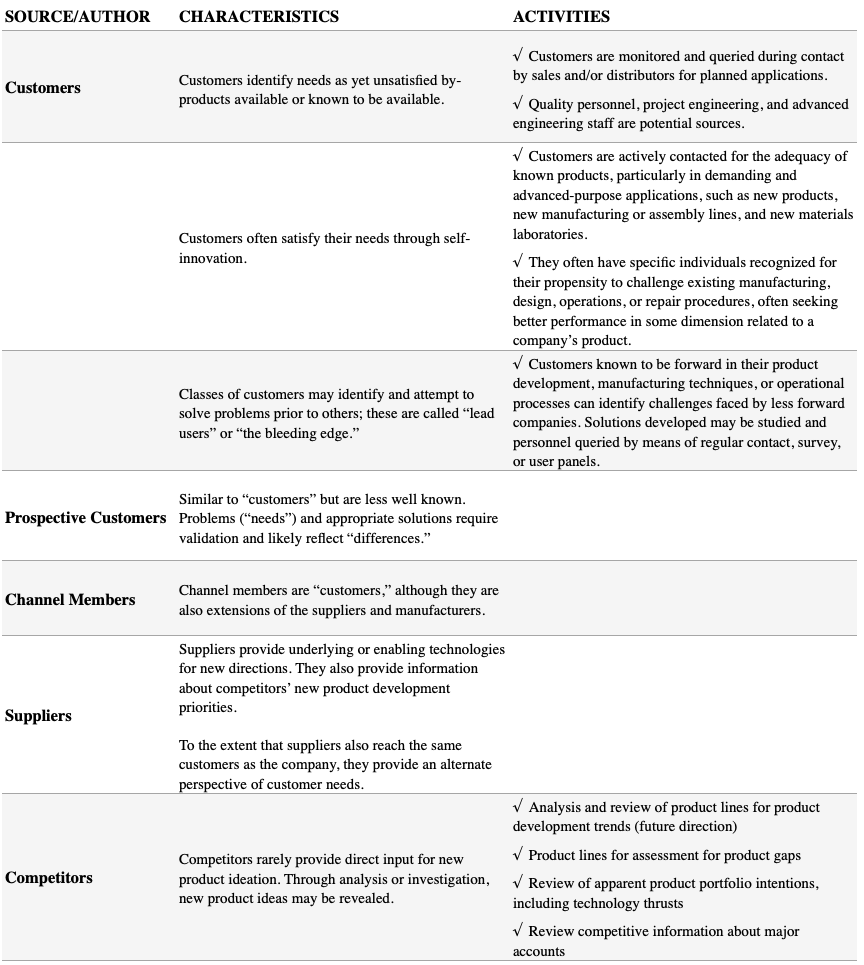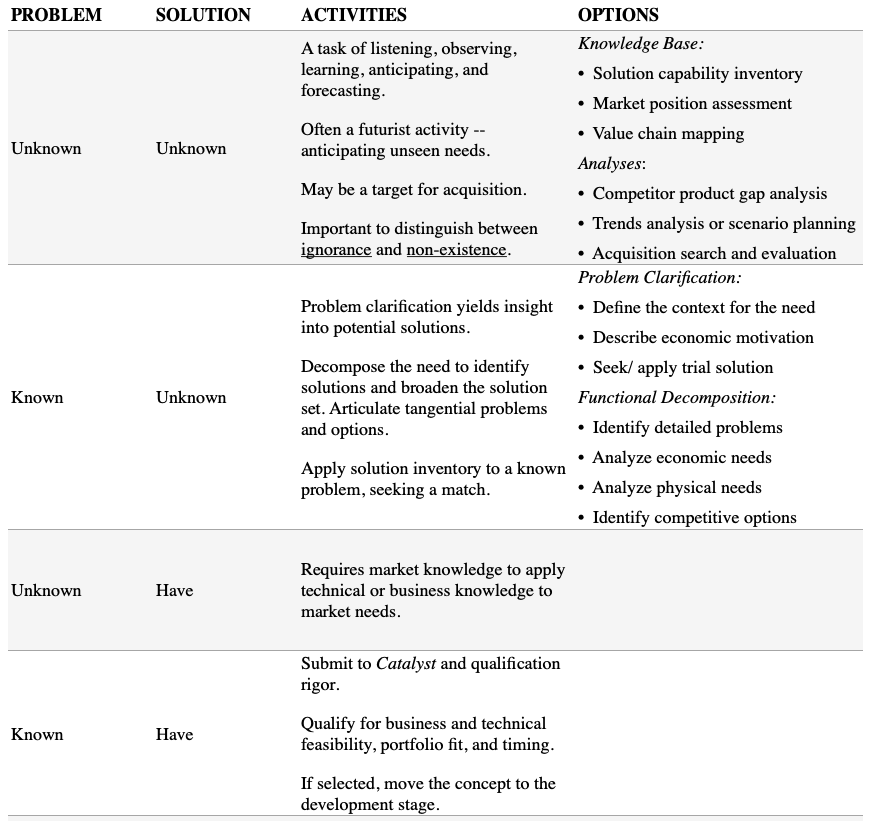The purpose of this article is to help you manage and facilitate the transformation of the abstract (sourcing innovative ideas) into the concrete (managing new product concepts).
We hope you beg, borrow, steal, and modify heavily from our technique called Product Concept Management (PCM or Catalyst). Whereas this is the third of three connecting articles, remember to see (1 of 3) and (2 of 3).
Catalyst describes our method for clarifying the “fuzzy front-end” in product development. Meanwhile, the “fuzzy front-end” represents the time and space between a thought (e.g., problem or solution) and the decision to act by first converting the thought into a concrete concept. For your questions or suggestions, please contact us at +01 (630) 954-5880 or by email at info@mgrushfacilitation.com.
MANAGING CONCEPTS DEPENDS ON QUALIFYING INNOVATIVE IDEAS
Managing innovative ideas relies on one primary task: qualifying innovative ideas As explained in our last article Converting Raw Product Ideas into Polished Product Concepts (2 of 3), managing concepts means improving the certainty of ideas. We do this by adding information to the description of the idea and the pains it cures. Now we more fully explain the skills supporting four primary activities to QUALIFY innovative ideas:
SKILLS REQUIRED
The qualifying activity requires a broad set of skills to interpret product descriptions, envision them being applied in the market, comprehend market structure (distribution, competition, customer segments), and reasonably assess new product idea revenues and profit-generating potential. Since no one person may have the required talents or time to do everything, Catalyst workshops provide a wonderful opportunity for qualifying innovative ideas.
The qualifier role, fulfilled by a single individual or a team, also identifies resources that are needed to complete the idea qualification. Resources may include production and technical experts, engineers, scientists, economists, sales managers, lobbyists, regulation experts, and experts in customers and competitors.
Summary of Qualifying Skills
Reminder about Sourcing Innovative Ideas and Managing Concepts
A fully qualified and complex product concept exceeds one descriptive sentence. The first QUALIFYING task reviews the idea for a minimal description, typically provided by the idea Author. To us, a comprehensive concept might also answer dozens of questions, such as:
A Raw Product Idea Transformed into a Manageable Product Concept with a Checklist of Issues
Technical/Physical Description
Describe the “need” (or “pain”) as a problem, want, or “hankering.” ABCs . . .
A. Ambition Size the opportunity in currency and units/volume
B. Benefits What are the benefits of the product to the buyer/customer? (Economic, emotional, . . .)
C. Choices What are the customer’s/user’s other options to solve the problem, satisfy the need or want, or achieve the improvement? Why? When, where, and how was the idea conceived?
Qualification Checklist
QUALIFYING enhances the character of a new product idea, enabling assessment and further development by adding information to the description of the idea. QUALIFYING also evaluates the idea for commercial potential and technical feasibility. A comprehensive Product Concept (qualified idea) resembles a business case.
SOURCING INNOVATIVE IDEAS
SOURCING innovative ideas requires one primary activity: discovering innovative ideas, and involves several supporting activities. The other activities support retrieval, including storing ideas and providing coaching, feedback, and incentives to idea authors. DISCOVERING innovative ideas depends on structuring a network of sources that feed raw or fragmented product ideas to our PCM technique.
MODES OF DISCOVERY
Continuous (Steady-State) Discovery
We advocate the design of a steady-state discovery apparatus to provide a continuous flow of ideas into Catalyst.
Based on understanding portfolio priorities, targeted markets, and technology priorities, the organization should structure information gathering, invention, and analysis activities to align with their future direction and constraints (available resources). Preferred sources of information might include:
- Channel members
- Competitors
- Customers
- Prospective customers
- Suppliers
Other sources include:
- Analogous markets (surrogate channels and suppliers)
- Experts in government and regulatory affairs
- Experts in specific technical and commercial subjects
Discrete (Singular) Discovery
Sometimes the need develops to seek innovative ideas through singular activities. Singular discoveries do not depend on regular, continuous activities. Discrete activities are similar to steady-state activities but differ in intensity, resource commitment, method, and results. Sources of information in discrete discovery activities are identical to the steady-state mode listed above.
DESIGN OF CONTINUOUS (STEADY-STATE) DISCOVERY
The principal characteristic of continuous DISCOVERY is the identification, training, equipping, and continual communication of resources involved in information gathering, analysis, and ideation.
Building The Network
Designing steady-state DISCOVERY requires identifying, prioritizing, and selecting network sources that can be accessed continuously. The option of actively seeking innovative ideas through intensive problem discovery, solution discovery, and other creative approaches already exists in most organizations – by way of existing customer-facing and other technically oriented resources.
We recommend a role-based network. Primary advantages when constructing a network include:
- Leverages existing reporting and support structures (such as IT for global access; contact between author and development, etc.).
- Leverages resources that are likely most qualified to establish communications between authors and their idea source (e.g., between a salesperson and customer).
- Uses existing resources, logistically positioned to minimize cost and responsiveness to local situations (improves overall performance, responsiveness, and consistency of contact between author and source).
PCM Leverages the Existing Network of Potential Authors and Sources
Summary of Networked Author/Source Characteristics
Technical resources, such as product and manufacturing engineering, laboratory scientists, installers, and field service technicians are valuable resources with “ears” and “eyes” tuned to problem DISCOVERY and pain identification. Customer-facing resources such as sales, marketing, distributors, and executives are valuable resources to listen for market opportunities.
Value Chain Approach
Use the value-chain perspective when constructing a PCM SOURCING network. Using the value chain as a guide, PCM identifies participants who can provide innovative ideas. The network includes target market segments from market strategies and focuses on products that harmonize with the product portfolio strategy.
Summary of Continuous Discovery Sources and Activities
DESIGN OF DISCRETE (SINGLE-EVENT) DISCOVERY
Discrete discovery mode provides a one-time selection of a method, participants, and target for the information gathering, analysis, or invention activity. Managers or team leaders organize single-event discovery opportunities. We recommend the use of the Problem-Solution Matrix (described below), to identify appropriate methods and tools.
Problem-Solution Matrix Summary
We’ve cut a lot of this series (three connecting articles) to keep each article to 2,000 words. Therefore, let us know where we over-cut or if you need further clarification and we promise to reply promptly.
______
Don’t ruin your career by hosting bad meetings. Sign up for a workshop or send this to someone who should. MGRUSH workshops focus on meeting design and practice. Each person practices tools, methods, and activities daily during the week. Therefore, while some call this immersion, we call it the road to building high-value facilitation skills.
Our workshops also provide a superb way to earn up to 40 SEUs from the Scrum Alliance, 40 CDUs from IIBA, 40 Continuous Learning Points (CLPs) based on Federal Acquisition Certification Continuous Professional Learning Requirements using Training and Education activities, 40 Professional Development Units (PDUs) from SAVE International, as well as 4.0 CEUs for other professions. (See workshop and Reference Manual descriptions for details.)
Want a free 10-minute break timer? Sign up for our once-monthly newsletter HERE and receive a free timer along with four other of our favorite facilitation tools.
Go to the Facilitation Training Store to access proven, in-house resources, including fully annotated agendas, break timers, and templates. Finally, take a few seconds to buy us a cup of coffee and please SHARE with others.
In conclusion, we dare you to embrace the will, wisdom, and activities that amplify a facilitative leader. #facilitationtraining #MEETING DESIGN
______
With Bookmarks no longer a feature in WordPress, we need to append the following for your benefit and reference
- 20 Prioritization Techniques = https://foldingburritos.com/product-prioritization-techniques/
- Creativity Techniques = https://www.mycoted.com/Category:Creativity_Techniques
- Facilitation Training Calendar = https://mgrush.com/public-facilitation-training-calendar/
- Liberating Structures = http://www.liberatingstructures.com/ls-menu
- Management Methods = https://www.valuebasedmanagement.net
- Newseum = https://www.freedomforum.org/todaysfrontpages/
- People Search = https://pudding.cool/2019/05/people-map/
- Project Gutenberg = http://www.gutenberg.org/wiki/Main_Page
- Scrum Events Agendas = https://mgrush.com/blog/scrum-facilitation/
- Speed test = https://www.speedtest.net/result/8715401342
- Teleconference call = https://youtu.be/DYu_bGbZiiQ
- The Size of Space = https://neal.fun/size-of-space/
- Thiagi/ 400 ready-to-use training games = http://thiagi.net/archive/www/games.html
- Visualization methods = http://www.visual-literacy.org/periodic_table/periodic_table.html#
- Walking Gorilla = https://youtu.be/vJG698U2Mvo

Terrence Metz, president of MG RUSH Facilitation Training, was just 22-years-old and working as a Sales Engineer at Honeywell when he recognized a widespread problem—most meetings were ineffective and poorly led, wasting both time and company resources. However, he also observed meetings that worked. What set them apart? A well-prepared leader who structured the session to ensure participants contributed meaningfully and achieved clear outcomes.
Throughout his career, Metz, who earned an MBA from Kellogg (Northwestern University) experienced and also trained in various facilitation techniques. In 2004, he purchased MG RUSH where he shifted his focus toward improving established meeting designs and building a curriculum that would teach others how to lead, facilitate, and structure meetings that drive results. His expertise in training world-class facilitators led to the 2020 publication of Meetings That Get Results: A Guide to Building Better Meetings, a comprehensive resource on effectively building consensus.
Grounded in the principle that “nobody is smarter than everybody,” the book details the why, what, and how of building consensus when making decisions, planning, and solving problems. Along with a Participant’s Guide and supplemental workshops, it supports learning from foundational awareness to professional certification.
Metz’s first book, Change or Die: A Business Process Improvement Manual, tackled the challenges of process optimization. His upcoming book, Catalyst: Facilitating Innovation, focuses on meetings and workshops that don’t simply end when time runs out but conclude with actionable next steps and clear assignments—ensuring progress beyond discussions and ideas.



